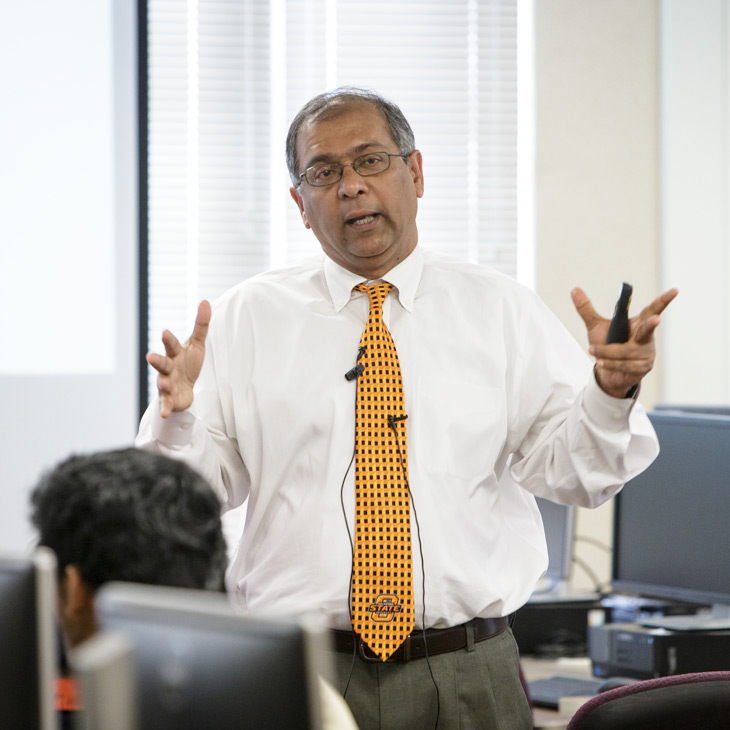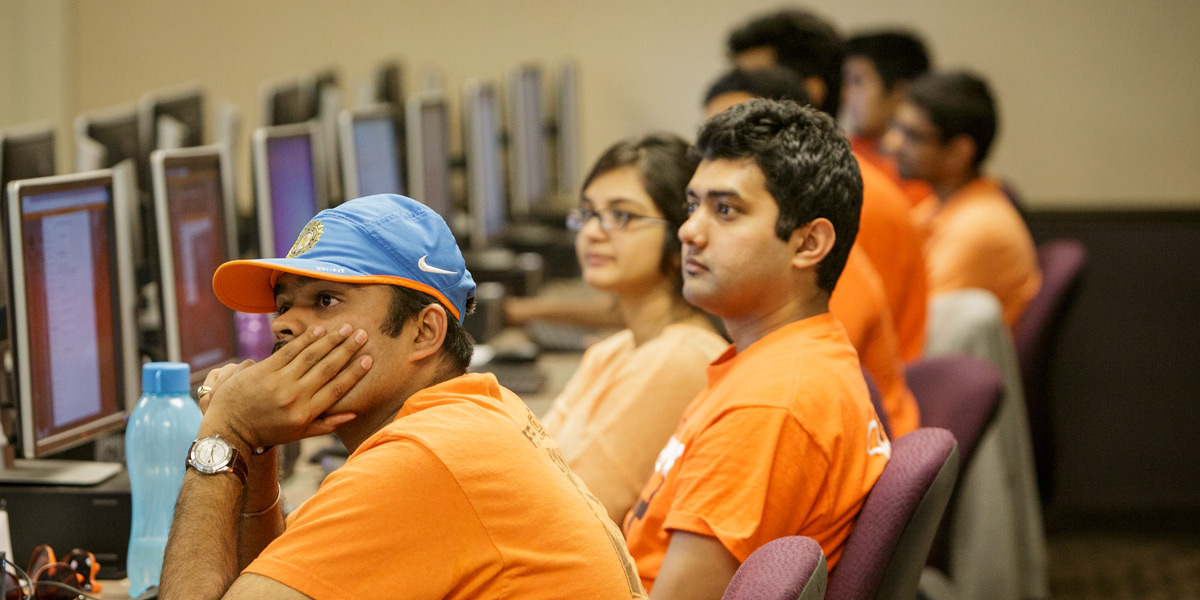Making Sense of It All

By Sonya Colberg
One beautiful autumn morning in 1986, Goutam Chakraborty stepped outside a classroom at the University of Iowa. The business grad student mentally sorted through his own personal big data file that had propelled him into a stark, new life.
Months earlier, the young marketing executive had been chauffeured around his hometown of Calcutta, India. His employer, a tobacco company, also paid for his luxury apartment and handed him a $10,000 travel and entertainment budget.
“What the heck have I done to myself? What have I done?” he said to himself that day.
At 27, he had effectively tossed those amenities out the polished limo door to become another poor college student eating ramen noodles in a $250/month efficiency apartment.
“I thought I’d made the biggest mistake of my life,” the Oklahoma State University marketing professor says with a laugh, sitting in his neat office in the Business Building on the Stillwater campus.
The founder of the data mining certificate program in OSU’s Spears School of Business says he had moved to Iowa City to stay just long enough to get a master’s degree in statistics and a doctorate in marketing. Then he’d return home to Calcutta.
But, unexpectedly, his passion kicked in to help students make sense of complicated data and use it to help businesses and possibly even the world. And that changed everything.
“It was unplanned. … Most of my fellow schoolmates back in engineering school still don’t believe that’s what I do these days,” says Chakraborty.
“They say, ‘No! It can’t be!’”
Now, the internationally recognized data mining and analysis expert has found his true calling as an American father … of about 700 kids.
Besides his own two teenage sons, Chakraborty’s family includes his “second set of kids” who have gone through his big-data certification program in the past 10 years.
A few years after joining OSU as a quantitative marketing professor in 1991, he worked with Dr. Marilyn Kletke, now-retired professor in the Management Science and Information Systems program, to launch a graduate-level data mining certification program, combining aspects of engineering, statistics and business with other disciplines.
The core level certificate requires students to complete 12 credit hours of specialized courses, with the expert level certificate requiring up to 21 credit hours. Chakraborty said few students are able to manage the master’s degree requirements and instead complete the 21-credit-hour level of expert certification.
Sponsored by business analytics software provider SAS, the stand-alone graduate certificate program attracts students undertaking master’s programs in various disciplines.
“If you like playing with data, if you like solving a problem, if you have intellectual curiosity and you have some bent of mathematical aptitude, this is the best field you can think of,” Chakraborty says.
Filling the Gap
As technology throws more and more data at business people, the issue of how to make sense of everything has grown.
In a 2011 study, research and consulting firm McKinsey and Co. discovered a yawning gap in that arena of the business world.
First, the firm identified a U.S. shortage of 140,000 to 190,000 people with deep, deep analytical expertise. Second, it identified a massive need for 1.5 million people who are not as deeply trained but know how to use data tools and techniques to make better decisions — the gap Chakraborty’s program helps fill.
“We can boast as much as we want, saying we have the best program,” says Chakraborty. “But let’s talk about validation from the marketplace.”
In the past 10 years, his students have presented 160 papers and posters at various conferences. Twenty-one OSU students have been honored with best paper or best poster awards. In fact, OSU students have nailed 12 top prizes in the SAS-sponsored Analytics Shootout, one of the largest analytics conferences in the world.
“We have been on the stage every year,” says Chakraborty. “There is not another university in the U.S. that has that record.”
Case Studies
Among numerous projects, Chakraborty’s students are working on a massive data problem for a Las Vegas casino company. For three of the company’s properties over about three years, students are examining what promotional materials work and which efforts waste time and money.
The work involves millions and millions of records and hundreds of columns.
“It’s something that is hard to manipulate and to make sense of. But, actually, if you ask me, that’s not a very big data problem,” Chakraborty says.
“It’s not, because a truly big data problem could be billions of records. But from a teaching point of view, a few million is fine.”
He laughs.
“You go from a mess of something to something managers can understand and take away and put into action,” he says. “And that’s really what we try to teach in the program.”
His students are also working on a social media effort, examining Twitter and social media to see how public sentiment shifted as the Ebola story evolved. They’ve found people shifted from feeling scared to mad to learning about preventative efforts.
The students examine the data and create “sentiment mining models” to track people’s sentiments about the topic.

One Strong Lineup
The Spears School has significant bench strength in analytics, with several professors teaching and doing research as well as Goutam Chakraborty.
Ramesh Sharda, vice dean of the Watson Graduate School of Management, and Dursun Delen are co-authors of the leading textbooks in analytics (www.pearsonhighered.com/sharda/). Sharda and Delen are also known for their work on applying data mining techniques for forecasting success of Hollywood movies. Sharda serves as the executive director of Teradata University Network, a group of academics that shares teaching and learning resources in analytics, and teaches a new course in Big Data technologies.
Rick Wilson, head of the Spears School’s Department of Management Science and Information Systems (MSIS), and Sharda were pioneers in applying neural network techniques to predict if a firm would go bankrupt. Wilson is well known for applying analytics in sports, and he teaches a very popular prescriptive analytics class in the MBA program.
Bryan Hammer joined the Department of MSIS in 2014. He is developing health care analytics applications with OSU’s new Center for Health Systems Innovation.
Thanks to this strength in analytics, OSU offers several programs to meet the needs of students and the industry. Two graduate-level certificates are available in marketing analytics and business analytics, and the MBA program allows for specializations in marketing analytics and data analytics.
Most of the current analytics coursework has been available as an analytics specialization under the Master of Science in MIS program. Going forward, the Master of Science in MIS program will include a specialization in Data Science.
Solutions Build Careers
Such projects and those OSU certificates have helped students find good jobs with well-known companies across the United States and beyond.
“If you ask me a company name, I can look it up on my database and say, ‘Yep, there’s someone from our program with that company,’ ” Chakraborty says.
Discover Card Financial Services, Capital One, SAS Institute and JP Morgan Chase have each hired 10 to 13 data mining and analytics students.
Love’s Travel Stops, Bank of Oklahoma and QuikTrip are just a few Oklahoma employers who’ve hired these students.
He knows this through feedback from employers and because many students stay in touch.
“I’ve reached the point in life where it doesn’t really matter what I do. But what my students do makes more of a difference to me. When they’ve done well, that’s what I’m most proud of,” Chakraborty says.
He recently visited a former student at his Oklahoma office and learned the young man had built a model that his boss recognized as an opportunity to create $1 million in additional revenue for the company.
Indeed, he says some of his proudest moments occur when former students tell him, “Dr. C, what you’ve taught us, I still use it.”
And … “Dr. C, I still have your notes.”
And … “I still go back and watch some of your videos.”
Chakraborty shakes his head in amazement and gently tucks those moments away into his personal big data file, along with memories of the straight-A report cards brought home by his biological kids and all the bits of touchstone evidence that they are good people.
Oh so slightly, Chakraborty pauses — a moment of reflection, perhaps.
“I’m very happy that I left the corporate world and became a professor — because I think that’s my calling,” he says.
“If anything, I’ve learned in life, you just have to follow where life takes you,” he adds. “If you are curious enough, passionate enough, you will find yourself.”

